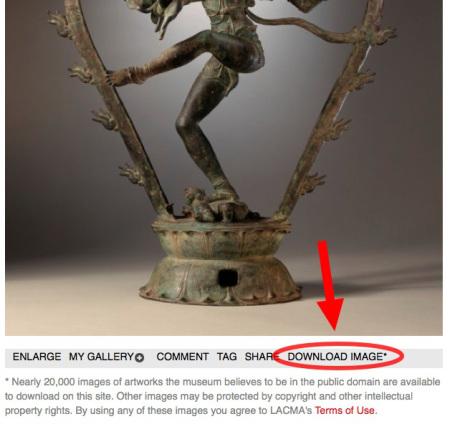Two years ago, we launched an experiment: an online image library where we made 2,000 high-resolution images of artworks that the museum deemed to be in the public domain available for download without any restrictions. This week, we’ve exceeded ourselves with the launch of our new collections website, giving away ten times the number of images we offered in the initial image library. Nearly 20,000 high-quality images of art from our collection are available to download and use as you see fit (that's about a quarter of all the art represented on the site). Just look for the “download” option beneath the photo of the artwork. (If you want to see all of the public domain artworks in the collection, run a search and then select "Show only unrestricted images" at the top of the page.)
Why would a museum give away images of its art? As Michael Govan often says, it’s because our mission is to care for and share those works of art with the broadest possible public. The logical, radical extension of that is to open up our treasure trove of images. When we first launched our early experiment with giving images away online, we heard a resoundingly positive response from many quarters: school teachers, parents, graduate students, journalists and the occasional creative person interested in printing their own Mother’s Day cards. So far, we have yet to hear of a situation where one of our public domain artworks has been misused or abused.
The new collections website does more than just give images away. It also uses a powerful open source search technology to create an interface that makes it easier than ever to sift through the roughly 80,000 works of art we have online. Whereas our old website privileged curatorial distinctions as the primary way into the museum’s treasures (“American art” versus “Art of the Pacific” and so on), the new site lets you decide where to dive in.
 One of my favorite features is the “On View” facet. Select a location in the museum, and you can see all of the results in our database that are on view in that location. It seems so obvious, right? But this is the first time our visitors (and our staff!) can go online, or whip out an iPad in the galleries, and quickly see, for example, all the works on view in the Ahmanson Building on the second floor—from Roy Lichtenstein’s Cold Shoulder, to Lee Bontecou’s fantastic Fish, and Marino Marini’s Horse and Rider. The location information updates every night, so you’ll know about a new work on view almost as fast as we do.
One of my favorite features is the “On View” facet. Select a location in the museum, and you can see all of the results in our database that are on view in that location. It seems so obvious, right? But this is the first time our visitors (and our staff!) can go online, or whip out an iPad in the galleries, and quickly see, for example, all the works on view in the Ahmanson Building on the second floor—from Roy Lichtenstein’s Cold Shoulder, to Lee Bontecou’s fantastic Fish, and Marino Marini’s Horse and Rider. The location information updates every night, so you’ll know about a new work on view almost as fast as we do.
Faceted search, which is what this is called, combines the ubiquitous direct search (an open search box, like Google) with navigational search (structured hierarchies and taxonomies, derived from library and information science). The end result is that you can now indulge your personal idiosyncrasies on our new collections website running lightning-fast searches for anything you can think of.

And apparently a great many of you are thinking about cats, because “cat” has regularly come up in our web usage report as a highly popular search term. If I enter “cat” in the open search box on our new website, in a fraction of a second, I’m faced with 210 LACMA cats. If I then scroll down to “chronology” on the left side of my results, I can see that these cats span the range of human history. This particularly jaunty statue with his pierced ear dates back to sometime between 1081 and 525 BC. He makes a fine companion to this mid-twentieth century Japanese example.
By the way, if you want to save your favorite records all in one place, choose “My Gallery” beneath any image. You’ll be prompted for a simple login username and password. Once you’ve registered, you’ll be able to save your favorites for future reference. You can even add comments, and help us tag the collection to make search smarter and more responsive to the way the public uses the site.
Have a question about a work of art you see in our collection? Log in and share your question in the comments section--our curators and research library staff have offered to field these questions, creating an open online dialogue about our evolving knowledge (and yours) regarding the works of art at LACMA.
Enjoy!
P.S. Special thanks to our Drupal developers, Urban Insight; our collections information team led by Robyn Sanford and Robin Chung; our in-house developer James Vitale; and our digital asset manager Heidi Quicksilver!




